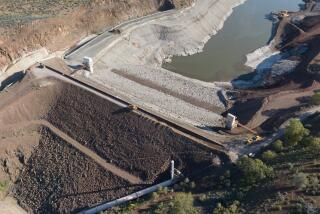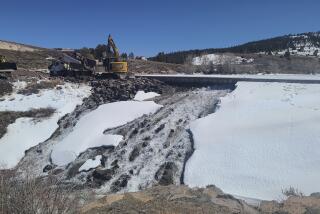Power of Nature, Folly of Man : Ruptured Dam Gains Monument Status
- Share via
AUSTIN, Pa. — Austin Dam is a broken monument to the power of nature and the folly of man.
The remains still stand, 77 years after the large concrete dam ruptured and wiped out the town of Austin on a sunny autumn afternoon.
The dam runs along Route 872 in Potter County, about a mile north of Austin in north-central Pennsylvania. Within a couple of years, the area may become a park--a memorial to at least 78 people who died.
The sleek, handsome structure, nearly 50 feet high and more than 550 feet long, was less than 2 years old when it broke on Sept. 30, 1911, unleashing a wall of water estimated at 20 feet to 35 feet high.
Now breached in several places, it looks like an ancient, conquered battlement.
Austin Dam is not found on road maps or on most lists of tourist attractions.
“It’s one of the best kept secrets in Pennsylvania,” says Robert Cooney, an Austin hardware store owner and self-proclaimed expert on the dam. “You’ve got to want to get there to go there.”
Last year, the federal government put Austin Dam on its National Register of Historic Places.
“It is significant both in creating a tragic flood and in fostering legislation to prevent such disasters,” says Department of Interior spokeswoman Debbie Kraybill. The disaster, second in Pennsylvania only to the 1889 Johnstown flood that killed 2,100, led to regulation and inspection laws for dams in Pennsylvania, Kraybill says.
The Southern Potter County Council of Governments, a coalition of small municipalities, has begun raising funds for a memorial park at the dam. It would include an access road, parking lot, picnic area and foot bridges over a creek.
“We want to make it accessible . . . but keep it as natural as possible--not commercialize it in any way,” says Dottie Bajor, a township supervisor who is the organization’s secretary-treasurer.
Only a small wooden sign stands above the dam now. Residents say state historical markers were taken by vandals.
Austin, which observed its centennial this year, is known as “the town too tough to die” and “the best town by a dam site.” It had nearly 3,000 residents before the dam broke. Today there are fewer than 800.
Bayless Pulp & Paper Co. opened a huge mill in 1901, bringing new hope to Austin, which faced hard times after the lumber industry declined.
Eight years later, Austin Dam was completed to provide water to keep the mill operating. An engineer on the project told Cooney the new dam was the largest concrete structure built at that time.
“People came here from all over to see that thing. They even called it the eighth wonder of the world,” Cooney says.
But Cooney says there were two cracks from the beginning.
In January, 1910, a sudden thaw filled the lake and caused the dam to bow out of alignment. Pressure was relieved by dynamiting a small hole into it.
On Sept. 30, 1911, a huge concrete plug blew out about 4 feet above the base on the west side. Water shot through, and the top caved in. Other sections disintegrated.
When the torrent reached the paper mill above Austin, it picked up many of the 700,000 stacked cords of lumber. That debris became the flood’s battering ram, destroying almost everything in its path.
Engineers determined that the dam lacked sufficient reinforcement rods and the foundation didn’t go deep enough into solid rock. Some argued that the upstream side of the dam should have been sloped, rather than perpendicular.
The paper company blamed the engineer who designed the dam, while the engineer blamed the company for not making repairs after the dam bowed in 1910. Litigation continued for years. Bayless, which reportedly paid about $600,000 in damages, rebuilt the plant and gave stock to flood victims.
More to Read
Sign up for The Wild
We’ll help you find the best places to hike, bike and run, as well as the perfect silent spots for meditation and yoga.
You may occasionally receive promotional content from the Los Angeles Times.






